If you are looking for a 100% Whole Wheat Bread that can be made with no added fat or sweetener, I have just the bread for you… It’s called Sprouted Whole Wheat Bread and it’s made with Super SproutTM from Lindley Mills.
Super SproutTM is a whole grain organic wheat that has been sprouted using a proprietary method and milled into flour for baking. The wheat flavor of this sprouted flour is deeper, smoother and more well-rounded than plain whole wheat flour.
I learned about Super SproutTM at the Asheville Bread Baking Festival during Peter Reinhart’s workshop. He baked some Sprouted whole wheat loaves and Sprouted Whole Wheat focaccia with Cranberries for the demonstration. Both were delicious.
I took the following photo before the room was filled to capacity. Everyone wanted to see what Peter Reinhart was up too. We weren’t disappointed.
First he showed us what the finished loaves look like. We got to sample them as well. Then he demonstrated how to make some artisan loaves with the dough.
I liked this method and the bread so much, I decided to get some of the flour and try it for myself.
The nutritional information on the package states that, “sprouting greatly enhances the nutrition and digestibility of wheat. The body sees sprouted wheat more as vegetable than a grain. The sprouting process jump-starts digestion and provides a far superior nutritional value for your body.”
Super Sprouted Whole Wheat Bread
Makes: 1 loaf
Source: Master Formula from Peter Reinhart’s workshop at the Asheville Bread Baking Festival
The dough is very easy to work with. It does not require a long fermentation time to develop the flavor or structure of the bread.
Due to the sprouting process, the sprouted wheat bread will remain soft and tender even without the addition of oil or fat which is usually added to 100% whole wheat bread. The flour is also naturally sweet so it does not require the addition of sweeteners for most breads. However, if you want to make sweet, enriched dough such as cinnamon buns or brioche, you can add some fat and sweetener.
Another interesting difference with sprouted wheat flour is that sprouting the wheat changes the flour enough so that many of the rules for artisan breads, such as the use of preferments and long, slow rising times aren’t necessary because the enzyme activity provided by the long fermentation times is already accomplished during the sprouting process. How cool is that!
Ingredients: (presented in Baker’s % / ounces / grams / teaspoons)
- 100% / 16 oz / 454g sprouted whole wheat flour
- 1.5% / 0.25 oz / 7g /1 teaspoon salt
- ~1% / 0.16 oz /4.5g /1 1/2 teaspoons instant yeast (1/2 oz – if using fresh yeast)
- 90.5% / 14.5 oz /411g water (room temperature)
Mix the dough
Mix on slow speed with the paddle (not the hook) for one minute. I used a Danish dough whisk rather than a stand mixer.
Let the dough rest for 5 minutes, then increase to medium speed and mix for two minutes. I mixed it again with the Danish dough whisk.
Fold and stretch the dough
Remove the dough to a lightly oiled work surface and perform one stretch and fold.
Transfer the dough to an oiled container (or cover the dough on the oiled work surface with a bowl). Perform three additional stretch and folds at 5 minute intervals (these intervals can be extended to up to twenty minutes each).
Bulk ferment
After the final stretch and fold, place the dough in an oiled bowl, cover, and ferment for 60 to 90 minutes at room temperature (shorter if using a proof box).
Shape the loaf
Shape the dough for either sandwich loaf or hearth baking. I wanted some whole wheat sandwich bread so I shaped it into a sandwich loaf. My dough was a little wet so it was a bit tricky to shape.
Final proof
Mist the top of the loaf with pan spray and cover loosely with plastic wrap (for hearth baking you can use a couche). Proof for 60 to 80 minutes, or as needed.
Bake the loaf
For hearth bread, bake at 450 degrees F/220 degrees C with steam for approximately 30 to 35 minutes. For sandwich loaf, bake at 375 degrees F/191 degrees C for approximately 45-55 minutes.
I baked my sandwich loaf at 350 degrees F until it registered 205 on an instant read thermometer. It was still a little bit sticky in the middle so I turned the oven off and opened the door but left the loaf in the oven for about 5 to 10 minutes more.
Remove from the oven and let the loaf cool on a wire rack.
I brushed the top of the loaf with butter, but once I tasted it, I realized it didn’t need the butter on top. I should’ve left it alone.
It tasted great plain or with butter or peanut butter. My taste tester described it as “total deliciousness!”
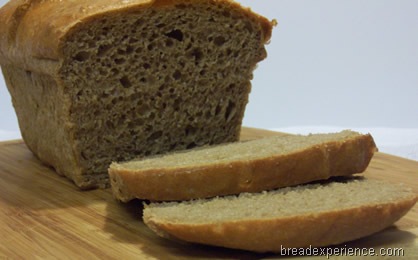
This bread has been YeastSpotted. Please visit Wild Yeast to view all of the lovely breads in the roundup.
I’m sure you’ll want to try this sprouted wheat flour too. The cost of the flour was very reasonable. I was able to make this bread for under $2.00 since I didn’t have the extra cost of the fat or sweetener just a little bit of salt and the dried yeast.
Thanks for joining me in the bread baking blog. I hope you’ll join me again soon.
Happy Baking!
Cathy
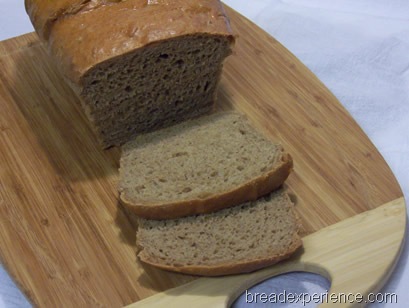
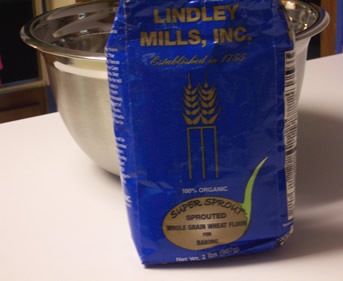



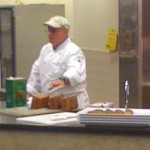
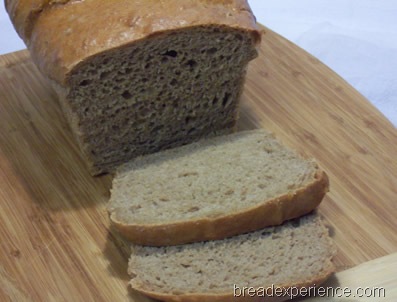
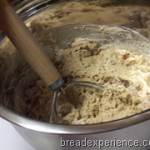

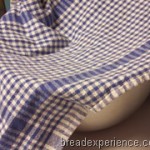

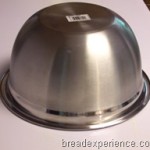
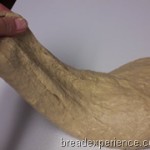
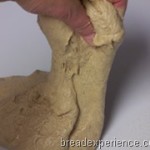
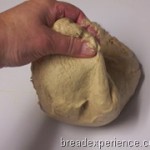
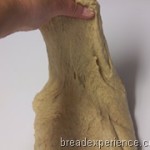
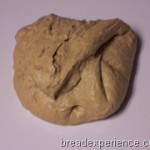
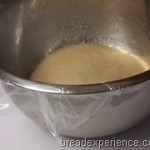
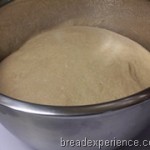
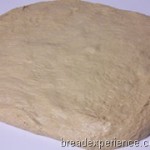
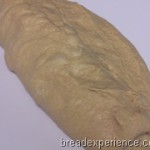
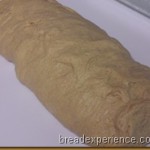
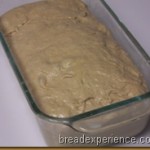
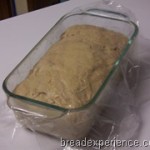
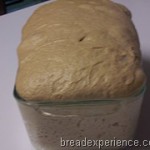
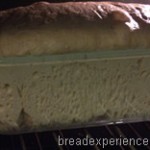

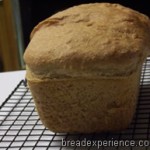
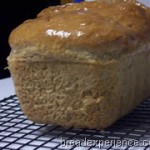
Melanie says
Oh my, that looks good!! I’d like to try that flour. I hope it comes to Meijer or Whole Foods or Fresh Market. I’m going to have to put the Asheville bread festival on my calendar for next year. I forgot all about it this year, until I heard you mention it.
Elwood says
Great loaf! Peter would be proud. I haven’t tried making it yet, but it’s high on my list.
I’m in one of your pictures. 🙂 Right in the middle of the shot of the crowd for the demo.
Cathy (breadexperience) says
Thanks Elwood! How cool is that! I got your picture and didn’t even know it. Now you’ll get the credit. 😉
Michelle says
Another gorgeous loaf! Sounds like you had a great time at the festival too!
Clarice says
What a great experience, going to a bread baking festival in Ashville with Peter Reinhart! You and Elwood!
Karen says
Wow! I just made a loaf, following your directions almost exactly. My only change: I used the originally mentioned 375 degrees because I used a metal pan (I noticed you Amadeus the change in temp for your glass pan). I had never used the “stretch and fold technique before. I used a 9 by 5 pan. I may try it in a half inch smaller pan with the longer bake time for a higher loaf next time, but not sure. It is a beautiful bread. I got a hollow area just under the crust one one end, but at my only moderate skill level, I’m thrilled with the results. You are so right, no bitterness, no dryness. Hard to believe. It really is a wonderful bread. This was my first time working with sprouted wheat flour. I lucked into buying a bag and hope I will be able to finding more Lindley Mills in the future. Thank you so much for the time and effort you put into this posting. Karen
Cathy (breadexperience) says
Karen I’m so glad you liked this bread. I need to make some more bread with this flour. I like it too.
Anonymous says
TJ said…
Hello Again! Thank you so much for the link. I made the bread yesterday. The loaf is actually edible! I substituted some of the water for honey since my family likes their bread a bit on the sweeter side. My loaf did not come out nicely rounded like yours, though. It was a bit flat. Could it have been because of the honey? Also, I didn’t use instant yeast, but rather, baker’s active dry yeast. It’s been in my fridge for ~2 weeks. I looked up how much to add and the info I found said 1.25 as much as instant. Finally, I don’t have a mixer or a dough whisk, so I mixed by hand. I proofed for 60 minutes each time. Could any of this have led to a flatter top? Also, is the bread supposed to be dense? Mine didn’t come out too dense, but you definitely get full with a not-too-thick slice. Overall, though, only my second time making bread and considering the disaster from the day before, I am looking forward to trying other recipes. BTW, almond butter is great with it.
Cathy (breadexperience) says
Hello TJ, I’m answering the comment you submitted on the Sprouted Wheat Bread post here since you were referring to this bread.
I’m glad your loaf is edible. Mine was hardy but not necessarily dense. I found it very tasty. I didn’t think it needed any extra sweetener. Keep in mind that this is a whole wheat bread so it will be a bit denser than white bread. I usually use instant yeast and active dry yeast interchangeably in terms of the amount used.
I would recommend making this bread per Peter Reinhart’s formula and see if you get different results. BTW, this recipe works well with a big spoon. That’s what he used in his demonstration.
Tanbir says
Hi Cathy,
The bread came out brilliant !! Rose like a dream, had a wee bit dense structure in the bottom half…..and probably m impatience made the centre a wee bit gooe !!
Overall?? Brilliant ! Thanks.
What is the size of your loaf pan? And could it have been dense because i used a 8″ X 4″ Pan ?
Cathy Warner says
Hello Tanbir! I’m so glad you’re bread turned out. I used an 8 1/2″ x 4 1/2″ glass loaf pan. I don’t think the pan would’ve made the loaf dense. It sounds like maybe you didn’t bake it quite long enough.
Nili says
Hi, I was wondering what is the weight of the finished loaf using this recipe (with 16 oz of sprouted flour)?
Thanks!
Cathy says
I haven’t weighed the finished loaf, but the total weight of the ingredients is 30.91 ounces and 876.5 grams.
Deanne Isaacson says
Can you just add a tablespoon of honey to this recipe without altering any thing else?
Cathy says
Hi Deanne, yes you should be able to add a tablespoon of honey without altering anything else if you want to add some sweetener.
Monnie Holt says
I’m a total newbe to baking so i apologize if this question is novice: 16 oz sprouted flour by weight or by volume? Same question for the water. Are the oz fluid or dry?
Monnie Holt says
Also, can I double or tripple without modifying ratios?
Cathy says
You can double or triple the formula; however, you probably will not need as much yeast. 4 1/2 teaspoons is what you would get if you tripled the 1 1/2 teaspoons of yeast. It’s okay to use that amount if you adjust the proofing time. Otherwise, it might overproof. Hope this helps.
Cathy says
Hi Monnie,
That is a great question. I wouldn’t consider this a novice question. The measurements for this loaf are by weight because weighing your ingredients is more accurate than using cups (volume). So the 16 ounces for the flour is by weight and the water, fluid. I typically use grams because it’s much easier to work with when converting formulas.
Sandy says
Isn’t yeast bad for you though? I love the transformation of the sprouting but aren’t you messing it up by using yeast, as far as being healthy bread? Another question is whether or not the sprouted flour is organic? I can’t see the words on the picture. If not organic, then pesticides kill the whole sprouting thing. Since it did sprout, you at least don’t have GMOs.
Cathy says
Hi Sandy, this sprouted wheat flour is organic. As far as I know, Lindley Mill only mills organic flours. It’s up to you whether you want to use yeast or not.
Wendi says
Hello, I’ve been gifted a bread machine and have got some sprouted whole wheat flour ready to try it. Would this recipe work in a bread machine or would I need to change anything?
Cathy says
Hi Wendy, How nice that you received a bread machine as a gift. I have not tried making sprouted wheat bread in a bread machine, but you could try it. My concern is that it might overmix and/or overproof the dough. To compensate, use could use less yeast, maybe only 1 to 1 1/4 teaspoons to start with and see how it goes. You might also want to just let the machine mix and knead the dough and stop the machine before it gets to the final rise. Then shape the loaf by hand and place it in a loaf pan for the final rise, then bake in a conventional oven. If you do decide to try it in the bread machine, please let me know how it goes.
Earl Pitcher says
My bride of 43 years is very much in love with recapturing methods of cooking and baking used by some of our ancestors. We have used Spelt, Quinoa, ancient grains, etc., with varying results. However, it was our daughter who introduced us to Sprouted breads and wraps, not home made. Recently we discovered where we can buy Sprouted flour.
I first made biscuits’, and they were full of unique but tasty flavours. Today, I decided to try my hand at making Sprouted Wheat Bread and happened upon your blog. I did not follow your directions exactly, but made bread according to your ingredients’ list. The douge is covered and rising, and I am excited to taste the final product.
Thank you for sharing.
Cathy says
Hello Earl,
Thank you for visiting my blog. Do let me know how your bread turns out. And if you have a different method that you’d like to share, I would love to hear about it.
Happy Baking!
Cathy